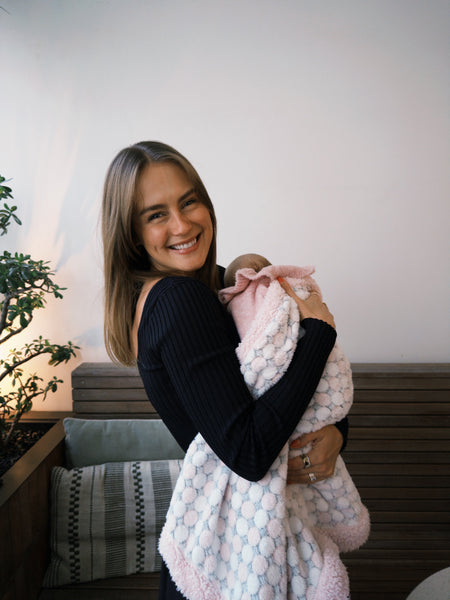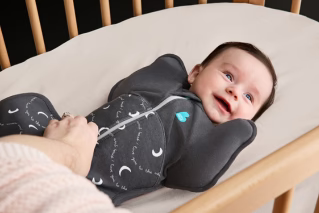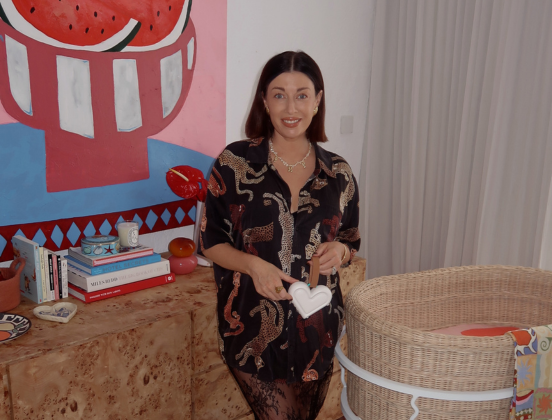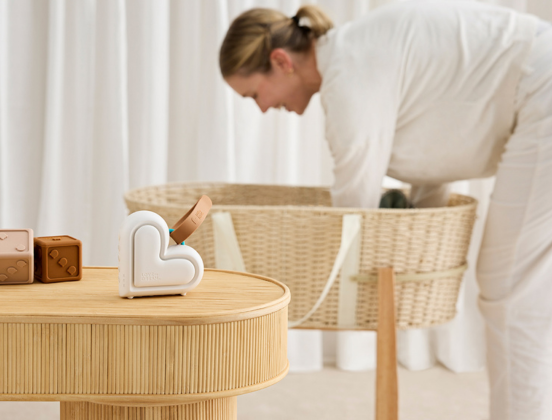What is white noise?
White noise contains every frequency audible to the human ear in equal amounts creating a humming sound. It often sounds like a high-pitched ‘shhh’, as our brain amplifies the higher-pitched region of the noise.
White noise is considered soothing for some children and an effective tool for sleep, as it creates a constant background sound that helps to mask other disruptive sounds. People often liken white noise to the static that comes from an untuned radio or television.
Pink noise vs white noise
Like white noise, pink noise is a broadband sound that also contains all the frequencies that humans can hear.
But what’s different is that pink noise is quieter than white noise, as it decreases by three decibels with each higher octave. Pink noise is more intense at lower frequencies, which creates a deeper, flatter sound.
Examples of white noise:
- A vacuum.
- Radio or television static.
- A fan.
- A hairdryer.
- A car engine.
- A lawnmower.
- Running water.
Examples of pink noise:
- The sound of steady rain.
- The sound of a waterfall.
- Leaves rustling.
- The sound of the ocean.
How does white noise work for babies?
White noise creates a masking effect, blocking out loud noises which may disturb your child’s sleep such as the television, older siblings, or traffic outside. Some white noise machines remind children of being in the womb due to the continuous background sound.
Is white noise good for babies?
The benefits of white noise for babies
- White noise can block out disruptive sounds such as older siblings, traffic outside, dogs barking, or the television.
- White noise can be adjusted depending on your child’s needs.
- Some parents and caregivers find it helps their little ones to drift off and stay asleep for longer periods of time.
- Some white noise machines have additional features, such as lullabies.
- White noise can also be a calming tool for parents and caregivers.
Considerations for Using White Noise
While white noise can be a fantastic sleep aid, there are a few things to keep in mind. Some children may become so accustomed to it that they struggle to sleep without it, which can be challenging when traveling or without access to the machine. Additionally, a quality white noise machine may come with a price—but Love To Dream™ offers a great option that’s budget-friendly. And, of course, every child is unique—not all babies respond to white noise in the same way.
Do babies sleep better with white noise?
White noise can help babies to sleep better as it blocks out other sounds which might disrupt sleep such as older siblings, a television in the other room, or outdoor traffic.
It can also recreate the feeling of being in the womb for some children. The womb is a noisy place with the sound of blood rushing and the heart beating. Continuous white noise can help settle your little one due to this calming effect.
What’s the best white noise for helping babies sleep?
We recommend investing in a white noise machine to help your little one sleep soundly - like the NEW Love To Dream Sleep Machine. The portable Love to Dream Sleep Machine is more than just a pretty shape. With easy-to-use, unique features such as cry detection and a personalised record function, the Sleep Machine pairs with our award-winning three-stage-sleep-system to help babies relax and feel more secure.
When should you start using white noise for your baby?
It’s never too early to start using white noise for your baby. Just make sure to always follow safe sleep guidelines.
How to use white noise safely:
You must always follow safe sleep guidelines. Please find ways to use white noise safely below:
- Always turn the white noise machine off or turn the volume down if your child is distressed.
- Always keep the white noise machine at least two metres away from your baby’s cot.
- Ensure the sound level never exceeds 50 decibels (no louder than a quiet conversation or a shower running). This may be the lowest setting on your machine.
- Always make sure the white noise machine is out of your child’s reach and any cords are safely tucked away.
- Always follow the manufacturer’s directions and safety warnings.
- Turn the white noise machine off when your child is asleep.
How loud should white noise be?
Studies have indicated that a lot of white noise machines are too loud for babies. It’s important to ensure that you never exceed 50 decibels. Over 50 decibels can be dangerous.
Should you play white noise all night for your baby?
No. It’s recommended that you turn the white noise machine off when your baby is asleep. You can either monitor your child or set a timer.
When to stop using white noise for your baby?
Every child is different. Some parents and caregivers wean their infant off white noise at two, three or four years old. However, white noise can be used at any age and some adults find it useful for sleep too. Always make sure to follow safe sleep guidelines and never exceed 50 decibels.
Weaning your child off white noise
We recommend slowly weaning your child off white noise if it has been a consistent part of their sleep routine. Start by slowly turning the white noise down (and eventually off) during their naps for two to three days.
Over the following two to three days, stick to the usual bedtime routine but start with the white noise machine turned down more than usual. Once your child is asleep, turn the white noise machine off.
Continue following this pattern for the next one to two weeks until you have completely removed the white noise machine from your child’s sleep routine. Remember every child is different and it may take longer for some to adjust than others.















